List of coffee drinks
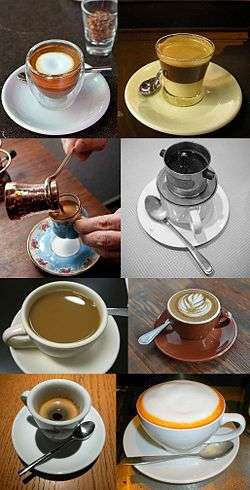
Coffee drinks are made by brewing hot water (or much less commonly, cold water) with ground coffee beans. The brewing is either done slowly by drip or filter, French press or cafetière, percolator, etc., or done very quickly under pressure by espresso machine, where the coffee is termed "espresso"—slow-brewed coffees are generally regarded simply as "coffee". All coffee drinks are based on either coffee or espresso, in different strengths; some drinks have milk or cream added, some use steamed milk, cream plant based milk, or foamed milk, some have flavorings or sweeteners, some have alcoholic liqueurs added, some are combinations of coffee with espresso or tea.[1]
With the invention of the Gaggia machine, espresso, and espresso with milk such as cappuccino and latte, spread in popularity from Italy to the UK in the 1950s, then to America, and with the rise in popularity of the Italian coffee culture in the 1980s it began to spread worldwide via coffeehouses and coffeehouse chains.[2][3]
The caffeine content in coffee beans may be reduced via one of several decaffeination processes to produce decaffeinated coffee (sometimes known as "decaf" coffee), which may be drunk as regular, espresso or instant coffee.
Infused
Drip or filtered
Drip-brewed, or filtered, coffee is brewed by hot water passing slowly over roasted, ground coffee beans contained in a filter. Water seeps through the ground coffee, absorbing its oils, flavours and essences, solely under gravity, then passes through the bottom of the filter. The used coffee grounds are retained in the filter with the liquid falling (dripping) into a collecting vessel such as a carafe or pot. Paper coffee filters were invented in Germany by Melitta Bentz in 1908.[4] To reduce waste, some coffee drinkers use fine wire mesh filters, which can be re-used for years.
French press or cafetière
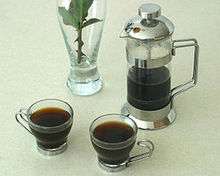
A French press, also known as a press pot, coffee press, coffee plunger, cafetière (UK) or сafetière à piston, is a coffee brewing device patented by Italian designer Attilio Calimani in 1929.[5] A French press requires coffee of a coarser grind than does a drip brew coffee filter, as finer grounds will seep through the press filter and into the coffee.[6]
Coffee is brewed by placing the ground coffee in the empty beaker and adding hot (93-96 degrees Celsius, 200-205 degrees Fahrenheit) water, in proportions of about 28 grams (1 ounce) of coffee to 450 ml (15 fluid ounces) of water, more or less to taste. After approximately four minutes the plunger is pressed to separate the grounds and hold them at the bottom of the beaker, then the coffee is poured.[7] Coffee press users have different preferences for how long to wait before pressing the plunger, with some enthusiasts preferring to wait longer than four minutes.
Cold brew
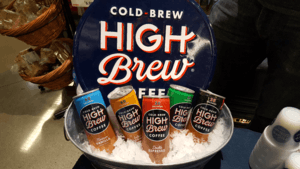
Cold brew, also called cold water extract or cold press, is the process of steeping coffee grounds in water at a cool or room temperature for an extended period. Coarse-ground beans are soaked in water for a prolonged period of time, usually 12 hours or more. The water is normally kept at room temperature, but chilled water is also used. The grounds are filtered out of the water after they have been steeped using a paper coffee filter, a fine metal sieve, a French press or felt, in the case of the "Toddy" brewing system. The result is a coffee concentrate that is often diluted with water or milk, and is served hot, over ice, or blended with ice and other ingredients such as chocolate. Slow-drip cold brew, also known as Kyoto-style, or as Dutch coffee in East Asia,[8] refers to a process in which water is dripped through coffee grounds at room temperature over the course of many hours.[9]
Because the coffee beans in cold-brewed coffee never come into contact with heated water, the process of leaching flavor from the beans produces a chemical profile different from conventional brewing methods.[10][11] Coffee beans contain a number of constituent parts that are more soluble at high temperatures, such as caffeine, oils and fatty acids. Brewing at a lower temperature results in lower acidity and lower caffeine content when brewed in equal volume.[12][13] It is around 65 to 70 percent less acidic than hot drip coffee or espresso, per part.[10] Although less caffeine is extracted with the cold brew method, a higher coffee-to-water ratio is often used, between 2 and 2 1/2 times. This may compensate for this difference in solubility, resulting in a brew with equal, if not more, caffeine (although this is unlikely).[14][15]
Boiled
Percolated
A coffee percolator is a type of pot used to brew coffee by continually cycling the boiling or nearly-boiling brew through the grounds using gravity until the required strength is reached. There are stove-top percolators and standalone units which contain a built-in heating element. Percolators were popular until the 1970s, when they were widely replaced by drip coffee makers. By the mid-1970s, many companies ceased production of percolators. In the 2000s, old 1970s-era percolators can occasionally still be seen at church functions and community events.
Turkish coffee

Beans for Turkish coffee are ground to a fine powder. Preparation consists of immersing the coffee grounds in water and heating until it just boils. This way, the foam is maximum. In the Middle East, four degrees of sweetness are used. The Turkish terms and approximate amounts are as follows: sade (plain; no sugar), az şekerli (little sugar; half a level teaspoon of sugar), orta şekerli (medium sugar; one level teaspoon), çok şekerli (a lot of sugar). The coffee and the desired amount of sugar are stirred until all coffee sinks and the sugar is dissolved before boiling. If the coffee is left to boil longer, less foam remains.
Turkish coffee is an Intangible Cultural Heritage of Turkey confirmed by UNESCO.[16]
Moka
Moka coffee is coffee brewed with a moka pot, a stovetop coffee maker which produces coffee by passing hot water pressurized by steam through ground coffee at a lower pressure than an espresso maker. The flavor of moka pot coffee depends greatly on bean variety, roast level, fineness of grind, and the level of heat used. Due to the higher-than-atmospheric pressure involved, the mixture of water and steam reaches temperatures well above 100 °C, causing a more efficient extraction of caffeine and flavors from the grounds, and resulting in a stronger brew than that obtained by drip brewing.
Vacuum coffee
A vacuum coffee maker brews coffee using two chambers where vapor pressure and vacuum produce coffee. This type of coffee maker is also known as vac pot, siphon or syphon coffee maker, and was invented by Loeff of Berlin in the 1830s. These devices have since been used for more than a century in many parts of the world and more recently have been given a new use by molecular mixologists and chefs to make hot cocktails and broths.[17]
Espresso and variations
Espresso is brewed by using an espresso machine to force a small amount of nearly boiling water and steam – about 86 to 95 °C (187 to 203 °F) – under pressure through finely ground and compacted coffee.[18][19] The espresso machine was patented in 1901 from an earlier 1884 machine,[20][21] and developed in Italy; with the invention of the Gaggia machine, espresso spread in popularity to the UK in the 1950s where it was more often drunk with milk as cappuccino due to the influence of the British milk bars,[22][23][24] then America in the 1980s where again it was mainly drunk with milk,[25] and then via coffeehouse chains it spread worldwide.[3] Espresso is generally denser than coffee brewed by other methods, having a higher concentration of suspended and dissolved solids; it generally has a creamy foam on top termed "crema".[26] Espresso is the base for a number of other coffee drinks, such as latte, cappuccino, macchiato, mocha, and Americano.[27]
- Caffè Americano
.jpg)
Caffè Americano or simply Americano (the name is also spelled with varying capitalization and use of diacritics: e.g. Café Americano, Cafe Americano, etc.) is a style of coffee prepared by adding hot water to espresso, giving a similar strength to but different flavor from brewed coffee. The drink consists of a single or double-shot of espresso combined with between 1 and 16 fluid ounces (30–470 ml) of hot water. The strength of an Americano varies with the number of shots of espresso added. In the United States, "Americano" is used broadly to mean combining hot water and espresso in either order. Variations include long black and lungo.
- Café Cubano
Cuban tradition is to drink coffee strong and sweet, often mixing the sugar with the coffee beans before brewing. The traditional method of brewing coffee was a filter method using a cloth cone; this has mostly been replaced with an aluminium cafetera or coffeemaker - in tourist areas some cafes will have an espresso machine, though espresso machines are expensive, so espresso is not a common drink for most Cubans.[28][29] Though quality coffee is grown in Cuba, it is expensive, so most Cubans drink coffee imported from Puerto Rico, and often mixed with ground peas.[30][31] The Cuban habit of brewing coffee with sugar has spread to Miami, West Palm Beach, Tampa and the Keys, where espresso is the preferred brewing method, and an espresso brewed with sugar is termed Café Cubano, Cuban coffee, Cuban espresso, cafecito, Cuban pull, or Cuban shot.[32] Sometimes demerara sugar is used, and sometimes the sugar (white or brown) is not brewed with the coffee, but is placed in the cup as the coffee is dripped into it, then stirred into a froth.[33][34] Variations on the Miami café Cubano are with a splash of milk - cortadito; and with steamed milk - café con leche.[35]
- Caffè crema
Caffè crema (Italian: cream coffee) refers to two different coffee drinks:[36] an old name for espresso (1940s and 1950s), and a long espresso drink primarily served in Switzerland and Austria and northern Italy (1980s onwards), along the Italian/ Swiss and Italian/ Austrian border.[37] As a term, it generally means "espresso", while in technical discussions, referring to the long drink, it may more narrowly be referred to as Swiss caffè crema. Variant terms include "crema caffè" and the hyperforeignism "café crema" – "café" is French, while "caffè" and "crema" are Italian, thus "café crema" mixes French and Italian.
- Cafe Zorro
A Cafe Zorro is a double espresso or doppio, added to hot water with a 1:1 ratio.
- Doppio
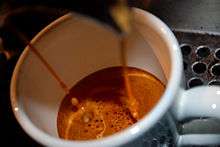
Doppio is a double shot, served in a demitasse cup.[38]
- Espresso Romano
An espresso Romano is a shot of espresso with a slice of lemon served on the side. The lemon can be run along the rim of the cup as a way to accentuate the espresso's sweetness.[39] Despite the name, it has no link to Italy nor Rome.
- Guillermo
Originally one or two shots of hot espresso poured over slices of lime. It can also be served on ice, sometimes with a touch of milk.
- Ristretto
Ristretto is traditionally a short shot of espresso made with the normal amount of ground coffee but extracted with about half the amount of water. Since ristrettos are essentially the first half of a full length extraction, the faster-to-extract compounds predominate in a ristretto. The opposite of a ristretto is a lungo, which is typically double the shot volume. Ristretto means “limited” or “restricted” in Italian whereas lungo means “long.”
Straight ristrettos—shots that are traditionally drunk from a demitasse and not diluted into a larger cup containing milk or water—could be described as bolder, fuller, with more body, and less bitterness, but with a higher concentration of acidity. These characteristics are usually attributed to espresso in general but are more pronounced in a ristretto. Diluted into a cup of water (to make an Americano or long black) or milk (e.g. latte and cappuccino), ristrettos are less bitter and exhibit a more intense espresso character.[40]
With milk
Johan Nieuhof, the Dutch ambassador to China, is credited as the first person to drink coffee with milk when he experimented with it around 1660.[41]
- Antoccino
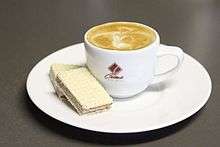
An antoccino is a single shot of espresso with steamed milk in a 1:1 ratio, served in an espresso cup. Despite the name, it has no link to Italy, nor any meaning in Italian.
- Breve
Espresso made with a steamed mixture of half milk and half cream (i.e., half and half); size can vary – the name relates to the use of cream and milk.[42][43]
- Café au lait

A café au lait is traditionally the French way of preparing 'coffee with milk' both at home and in Cafés in Europe. "Café au lait" stems from the same continental tradition as "caffè latte" in Italy, "café con leche" in Spain, "kawa biała" ("white coffee") in Poland, "tejeskávé" in Hungary, "Milchkaffee" in Germany, "Melange" in Austria,[44] "koffie verkeerd" in Netherlands, and "café com leite" in Portugal, meaning simply "coffee with milk". In northern Europe, café au lait is the name most often used in coffee shops for what other places is a 'caffè latte'. The term 'café au lait' has been used for espresso and milk since the 1950s in among other places the UK, Netherland, Belgium, Germany, Denmark, Norway and Sweden. In the US, café au lait is defined as a coffee drink consisting strong or bold coffee (sometimes espresso) mixed with scalded milk in approximately a 1:1 ratio.
- Ca phe sua da
Vietnamese cà phê sữa đá or "iced milk coffee", is made with a dark roast, often with chicory, brewed with a small metal Vietnamese drip filter into a cup containing sweetened condensed milk. The condensed milk and coffee are stirred together and then poured over ice. Ca phe sua nong (Vietnamese: 'cà phê sữa nóng') – literally, "hot milk coffee" – does not include the ice.
- Café bombón
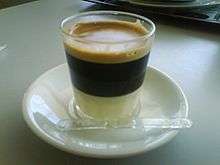
Café bombón was made popular in Valencia, Spain, and spread gradually to the rest of the country. It might have been re-created and modified to suit European tastebuds as in many parts of Asia such as Malaysia, Thailand and Singapore the same recipe for coffee which is called "Kopi Susu Panas" (Malaysia) or "Gafeh Rorn" [lit: hot coffee] (Thailand) has already been around for decades and is very popular in "mamak" stalls and "kopitiams" in Malaysia. A café bombón, however, uses espresso served with sweetened condensed milk in a 1:1 ratio whereas the Asian version uses ground coffee and sweetened condensed milk at the same ratio. On the Canary Islands a variety named "Café Proprio" or "Largo Condensada" is served using the same amount of condensed milk but a "café largo" or espresso lungo. For café bombón, the condensed milk is added to the espresso. For visual effect, a glass is used, and the condensed milk is added slowly to sink underneath the coffee and create two separate bands of contrasting colour – though these layers are customarily stirred together before consumption. Some establishments merely serve an espresso with a sachet of condensed milk for patrons to make themselves.
- Cappuccino

Cappuccino is a coffee-based drink prepared with espresso, hot milk, and steamed milk foam. A cappuccino differs from a caffè latte in that it is prepared with much less steamed or textured milk than the caffè latte with the total of espresso and milk/foam making up between approximately 150 and 180 millilitres (5 and 6 US fluid ounces). A cappuccino usually exceeds the height of the cup, making the foam visible above the side of the cup. A cappuccino is traditionally served in a porcelain cup, which has far better heat retention characteristics than glass or paper. The foam on top of the cappuccino acts as an insulator and helps retain the heat of the liquid, allowing it to stay hotter longer.
- Cortado
A cortado (also known as "pingo" or "garoto") is an espresso "cut" (from the Spanish and Portuguese cortar) with a small amount of warm milk to reduce the acidity. The ratio of milk to coffee is between 1:1 – 1:2, and the milk is added after the espresso. The steamed milk hasn't much foam, but many baristas make some micro foam to make latte art. It is popular in Spain and Portugal, in Norway as well as throughout Latin America, where it is drunk in the afternoon. In Cuba, it is known as a cortadito. It is usually served in a special glass, often with a metal ring base and a metal wire handle. There are several variations, including cortado condensada (espresso with condensed milk) and leche y leche (with condensed milk and cream on top). In the United States it is sometimes known as a "Gibraltar". Differs from cappuccino with little or no milk foam, and from flat white in that the flat white is always prepared with a double espresso and "wet" microfoam foam.
- Egg coffee
Egg coffee is a Vietnamese drink which is traditionally prepared with egg yolks, sugar, condensed milk and Robusta coffee.
- Eggnog latte
An autumn and winter seasonal blend of steamed milk and eggnog, plus espresso and a pinch of nutmeg.
- Eiskaffee
Eiskaffee, literally "ice cream coffee", is a popular German drink consisting of chilled coffee, vanilla ice cream, and sometimes sugar or whipped cream.
- Espressino
An espressino is made from espresso, steamed milk, and cocoa powder, similar to the Marocchino.
- Espresso con panna
Espresso con panna is coffee with whipped cream.
- Flat white

Flat white is an espresso with a similar proportion of coffee to milk as a latte and a cappuccino, the main difference being the texture of the milk and (in some regions) the number of espresso shots.
The drink originated in Australia in the early 1980s as an alternative to the frothier cappuccino. It became popular in New Zealand in the late 1980s and has since spread to the UK, where it was first served at independent cafes in London such as Department of Coffee and Social Affairs and Speak Easy where owners and staff from New Zealand brought the style of coffee into the UK before being adopted by chains Costa Coffee and Starbucks.[45] Available in the form of a 12 oz. double latte from Starbucks in the US since January 6, 2015,[46] it is rarely found in continental Europe.
In Australia and New Zealand it is traditionally made with two shots of espresso topped with stretched and textured milk. The milk is prepared by steaming air into the milk and folding the top layer into the lower layers. To achieve the "flat", non-frothy texture the steamed milk is poured from the bottom of the jug, holding back the lighter froth on the top in order to access milk with smaller bubbles, making the drink smooth and velvety in texture. This leads to a white coffee with the crema on top still intact. The drink was traditionally served in a ceramic cup used for cappuccinos (approximately 220–260 ml in capacity), though present-day speciality cafes are more likely to serve it in smaller (150–160 ml) cups with two Ristretto shots used, resulting in a drink noticeably stronger and less milky than a caffè latte.
- Galão
Galão is a hot drink from Portugal made of espresso and foamed milk. Similar to caffè latte or café au lait, it comes in a tall glass with plenty of milk. With only half milk, it is known as "meia de leite"[47] In Madeira, a large, milky coffee is known as a "chinesa" (literally, "Chinese Lady").[48][49]
- Caffè gommosa
A shot of espresso poured over a single marshmallow. This originated in the coffeehouses of America's Pacific Northwest. The resulting drink is sweet and thick, leading to the "caffè gommosa" name which means "rubbery coffee."
- Kopi susu
Kopi susu is found in (at least) Malaysia, Borneo and Indonesia and very similar to the preceding entry for Ca phe sua nong. Literally, kopi susu means "milk coffee". Served in a glass, kopi susu can be made simply by mixing black coffee (arabica) with about a quarter to half a glass of sweetened condensed milk then let stand to cool and allow the grounds to sink to the bottom. You should not drink this to the end unless you want to "eat" the ground coffee. Kopi Turbruk is as above but uses sugar instead of sweetened condensed milk.
- Latte
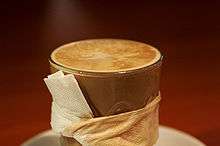
A latte is an espresso and steamed milk,[50][51] generally in a 1:3 to 1:5 ratio of espresso to milk, with a little foam on top.
In Italy it is called caffè latte or caffelatte, which means "coffee and milk". In northern Europe and Scandinavia the term 'café au lait' has traditionally been used for the combination of espresso and milk, but this term is used in the US for brewed coffee and scalded milk. In France, 'caffè latte' is mostly known from American coffee chains; a combination of espresso and steamed milk equivalent to a 'latte' is in French called 'grand crème' and in German 'Milchkaffee' or 'Melange'. In Portuguese it is called galão.
Variants include replacing the coffee with another drink base such as masala chai (spiced Indian tea), mate or matcha, and other types of milk, such as soy milk or almond milk are also used.
- Latte macchiato
Latte macchiato literally means stained milk. This refers to the method of preparation, wherein the milk gets "stained" by the addition of espresso. It differs from latte firstly in that espresso is added to milk (rather than milk to espresso), secondly that it features more foam, rather than simply hot milk, thirdly in that often only ½ (or less) of an espresso shot is used, and fourthly in that it is often a "layered" drink, rather than being mixed as in a caffè latte. Simply, in a latte, the emphasis is on the coffee, while in a latte macchiato, the emphasis is on the milk.
- Macchiato
Macchiato, meaning "stained", is an espresso with a dash of foamed milk. At first sight it resembles a small cappuccino, but even if the ingredients are the same as those used for cappuccino, a macchiato has a much stronger and aromatic taste. The milk is foamed directly into the espresso cup, which is then put under the coffee outlet. The espresso is then drawn into the cup. Cocoa is sometimes sprinkled over the drink.[52] Often the process is reversed and milk foam is floated on top of extracted coffee. A long macchiato will have two shots of espresso and a small amount of hot water (as per long black). A short macchiato will usually have one shot of coffee and less water (as per short black).
- Wiener or Viennese melange
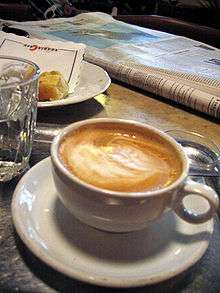
Melange is popular in Austria, Switzerland and the Netherlands, and is traditionally similar to latte and cappuccino (and more a mix of the two), a large cup with (today) espresso and steamed milk with some milk foam. Melange and cappuccino both have variations with whipped cream atop the blend of milk and coffee. Outside Vienna this is sometimes referred to as Wiener Melange, although that name does not exist there. The origin of Melange goes back to the 1700s as a Café drink (you wouldn't call it that at home) in Austria.
A Wiener Melange is a speciality coffee drink similar to a cappuccino. The difference is sometimes assumed to be that the melange is made with milder coffee[53] but the Viennese coffee company Julius Meinl describes a Wiener melange as "One small espresso served in a large cup of coffee. Steam milk and add milk foam to coffee (=small milk coffee)".[54] At Cafe Sperl in Vienna, the Melange is 1/2 cup "black coffee" and 1/2 cup creamy milk, completed by milk foam.[55]
- White coffee
Ipoh white coffee is a popular coffee drink which originated in Ipoh, Perak, Malaysia. The coffee beans are roasted with palm-oil margarine, and the resulting coffee is served with condensed milk. The taste is smooth and sweet, and is often served iced.
- White coffee (England)
White coffee is the old English alternative to a 'black coffee'; it is any form of black coffee with a small amount of fresh cold milk added.
- Vienna coffee
A Vienna coffee (not to be confused with "Vienna roast" coffee), is coffee or espresso topped with whipped cream. Milk is sometimes poured into the coffee/espresso before adding the whipped cream. Vanilla, chocolate or cinnamon is sometimes sprinkled on the cream.[56] Melange mit schlag (or schlagobers) is the Austrian term for coffee with whipped cream.[57] Austria has a number of coffees with whipped cream.[58]
Combinations
- Coffee with espresso
Regular coffee (slow brewed as with a filter or cafetière) is sometimes combined with espresso to increase intensity of flavour or caffeine.[59] This may be called a variety of names, most commonly "red eye",[60] "shot in the dark",[61][62] and "depth charge" – though this is a federally registered trademark of a company, Caribou Coffee, so usage is restricted.[63] Coffeehouse chains may have their own names, such as "turbo" at Dunkin' Donuts.[64] A double shot of espresso in the coffee may be termed a "black eye", and a triple shot a "dead eye". "Caffè Tobio" is a version with an equal amount of coffee to espresso.[65]
- Coffee with tea
- A black tie is a traditional Thai iced tea, which is a spicy and sweet mixture of chilled black tea, orange blossom water, star anise, crushed tamarind, sugar and condensed milk or cream, with a double shot of espresso.
- Numerous houses use the term chai latte to indicate that the steamed milk of a normal caffè latte is being flavoured with a spiced tea concentrate instead of with espresso. Add espresso shots for a dirty chai latte. Chai tea with a single shot of espresso. In addition, 1-2 tablespoons of instant espresso may be brewed while simultaneously steeping chai in the same container; a small amount of a dairy or non-dairy drink of choice is usually added to complete the drink.
- Red tie ia a traditional Thai iced tea, which is a spicy and sweet mixture of chilled black tea, orange blossom water, star anise, crushed tamarind, sugar and condensed milk or cream, with a single shot of espresso.
- Yuanyang, sometimes also called Ying Yong, is a popular drink in Hong Kong, made of a mixture of coffee and Hong Kong-style milk tea. It was originally served at dai pai dangs (open space food vendors) and cha chaan tengs (cafe), but is now available in various types of restaurants. It can be served hot or cold. The name yuanyang, which refers to mandarin ducks, is a symbol of conjugal love in Chinese culture, as the birds usually appear in pairs and the male and female look very different. This same connotation of "pair" of two unlike items is used to name this drink.
- Coffee with alcohol
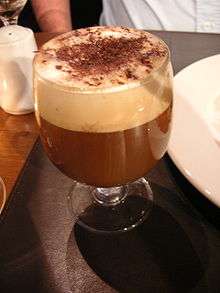
A liqueur coffee, as its name suggests, is a coffee brew with a 25 ml shot of liqueur. This brew is usually served in a clear, clean, pre-heated, liqueur coffee glass with the coffee and cream separated for good visual and taste effect. The liqueur of choice is added first with a teaspoon of raw cane sugar mixed in. The glass is then filled to within an inch of the top with good, strong, fresh filter coffee. Fresh, chilled, additive free, slightly whipped cream is then poured carefully over the back of a cold teaspoon, so that it floats on top of the coffee and liqueur mixture. The sugar is required in the coffee mixture to help the cream float.
- Gaelic coffee (Drambuie or Glayva)
- Irish Coffee (Whiskey)
- Brandy Coffee (Brandy)
- Keoke Coffee (Brandy and Kahlúa)
- English Coffee (Gin)
- Calypso Coffee (Tia Maria or Kahlúa and Rum)
- Jamaican Coffee (Tia Maria & Rum)
- Thai Coffee (Sangsom & 3 in 1 instant coffee)
- Shin Shin Coffee (Rum)
- Baileys Irish Cream Coffee
- VOODOO Cream Liqueur coffee
- Monk's Coffee (Bénédictine)
- Seville Coffee (Cointreau)
- Witch's Coffee (Strega)
- Russian Coffee (Vodka)
- Priest Coffee (Brennivín)
- Corfu Coffee (Koum Quat liquor)
- Kaffee Fertig (coffee with Swiss prune schnapps)
- Kaffee Kirsch (coffee with Kirschwasser)
- Kaffe Karlsson (coffee with Baileys Irish Cream and Cointreau)
- Caffè corretto (that is an Italian drink, consists of a shot of espresso "corrected" with a shot of liquor, usually grappa, brandy or sambuca.)
- Coffee liqueurs (ex. Kahlúa, Kamora)
- Kula (espresso with Amarula)
- Karsk, kaffegök or svartkopp (coffee with moonshine)
- Irish coffee is coffee combined with whiskey and cream, often further sweetened with sugar. Also available as a flavor of ice cream.
- Rüdesheimer Kaffee is an alcoholic coffee drink from Rüdesheim in Germany invented in 1957 by Hans Karl Adam. It is made with Asbach Uralt brandy with coffee and sugar, and is topped with whipped cream.
- A Pharisäer (Danish: farisæer), meaning a Pharisee, is an alcoholic coffee drink that is popular in the Nordfriesland district of Germany. It consists of a mug of black coffee, a double shot of rum, and a topping of whipped cream. In 1981, a court in Flensburg ruled that 2 centilitres (0.70 imp fl oz; 0.68 US fl oz) of rum were not sufficient for preparing a genuine Pharisäer.[66]
- A Carajillo is a Spanish drink combining coffee with brandy, whisky, anisette, or rum. It is typical of Spain and according to folk etymology, its origin dates to the Spanish occupation of Cuba. The troops combined coffee with rum to give them courage (coraje in Spanish, hence "corajillo" and more recently "carajillo"). There are many different ways of making a carajillo, ranging from black coffee with the spirit simply poured in to heating the spirit with lemon, sugar and cinnamon and adding the coffee last. A similar Italian drink is known as caffè corretto. The American version of a Spanish Coffee uses a heated sugar rimmed Spanish coffee mug with 3/4oz rum and 1/2oz triple sec. The drink is then flamed to caramelize the sugar. 2oz coffee liqueur is then added which puts out the flame, and then it is topped off with 3-4oz of coffee, and whipped cream.
- A Kula is an original African espresso drink combining espresso with Amarula liqueur to reduce the acidity and sweeten. The ratio of Amarula to espresso is between 1:2 – 1:3. It is becoming popular in Western and Southern Africa, and parts of New York where it is preferred as a breakfast drink due its "waking punch taste". It is usually served in a medium-sized espresso glass.
Flavoured
- Melya
Melya is coffee flavoured with cocoa powder and honey.[67] Cream is sometimes added.[67]
- Caffè Marocchino
The Marocchino is made from espresso, steamed milk, and a dusting of cocoa powder, similar to the espressino.
- Café miel
A café miel has a shot of espresso, steamed milk, cinnamon, and honey. The name comes from the French word for honey, miel.
- Mocha or café mocha or mochaccino
A café mocha is a variant of a caffè latte. Like a latte, it is typically one third espresso and two thirds steamed milk, but a portion of chocolate is added, typically in the form of a chocolate syrup, although other vending systems use instant chocolate powder. Mochas can contain dark or milk chocolate.
The term moccaccino is used in some regions of Europe and the Middle East to describe caffè latte with cocoa or chocolate. In the U.S. it usually refers to a cappuccino made with chocolate.
A "cafe borgia" is a mocha with orange rind and sometimes orange flavoring added. Often served with whipped cream and topped with cinnamon.
- Café de olla
Café de olla or pot coffee is a traditional coffee-based drink prepared using earthen clay pots or jars in Mexico and other Latin American countries. It is flavored with cinammon and piloncillo. Consumed primarily in colder weathers, usually with the merienda meal, and accompanied with pan dulce pastries.
- Miscellaneous
Some coffeehouses provide flavoured syrups which customers can have added to their coffee drinks. Some non-dairy creamers have flavoured versions, such as hazelnut flavour and Irish Cream flavour (the latter is non-alcoholic).
Iced
Frappé

Greek frappé (Café frappé) (Greek: φραπές) is a foam-covered iced coffee drink made from spray-dried instant coffee. It is very popular in Greece especially during summer, but has now spread on to other countries. There are numerous ways in which this coffee can be tailored to the individual's taste such as: all water-no milk; half-half; all milk and; varying levels of sweetness. Frappe is also extremely popular in the country of Cyprus where fresh milk is used as opposed to condensed. In French, when describing a drink, the word frappé means shaken or chilled; however, in popular Greek culture, the word frappé is predominantly taken to refer to the shaking associated with the preparation of a café frappé.
Greek Freddo Differantions
Freddo Espresso
Freddo Espresso is a foam-coved iced coffee made from the iced espresso. It is found in every café and coffee shop in Greece. It is undoubtedly popular among the young people during the summer, or the hot days. Because of the very hot summer in Greece, and the need to escape from the Frappé, people headed to make the other coffees into cold ones. It consists of two shots of espresso (30-50 ml), sugar, and ice (60- 100 ml) 1:2 ( espresso shots:ice). The espresso is made in a usually reusable metallic glass, after the amount of sugar is added. Next move is right after the brewing to insert the glass into the frapièra (It is a device with an electric motor that turns a metallic stick with a disk as a head at the point). The head of frapiera mixes the coffee with the sugar, produce the foam from the oils of espresso, and lowers the temperature. The coffee is ready and is poured to the glass (if it's take-away, it is plastic) wich already contains the wanted amount of ice cubes. The cubes are melted and the coffee reaches the right bitterness and strength in the first 10 minutes, because latter the ice is already melted to water and the strength is lower, with more watery feeling.
Freddo Cappuccino
Freddo Cappuccino is another variation of the original cappuccino. It is as popular as the freddo espresso. People who drink their hot coffee with milk during the cold months tend to drink freddo cappuccino in the summer. It follows the same process as the freddo espresso, but at the end foamed and cream milk is added in ratio 1:2 (espresso shots:milk), and 1:2 ( espresso shots:ice). Recently the Coffee Island coffee shop ( chain coffee shop in Greece), established a new foam and cream trend in freddo cappuccino. They use plant based milk, creamed in the frapièra, and poured over like the cow milk. The result is a stiffer and sweeter cream.
Other
- Mazagran
Mazagran (sometimes misspelled as Mazagrin) is a cold coffee drink that originated in Algeria. It is typically served in a tall glass, and is made with coffee and ice. Sometimes sugar, rum, lemon or water is added. Sometimes a fast version is achieved by pouring a previously sweetened espresso in a cup with ice cubes and a slice of lemon.
- Palazzo
A Palazzo is an iced coffee variant, popular in Southern California. It is two shots of espresso, chilled immediately after brewing and mixed with sweetened cream. A Palazzo is typically made using a moka pot.
- Ice Shot
Originating in Australia and similar to the Mazagran, the minimal Ice Shot is a single shot of fresh espresso poured into an ordinary latté glass that has been filled with ice. The hot coffee, in melting some of the ice is diluted, re-freezing to a granita-like texture. The addition of a single scoop of ice-cream on top is a popular variant. No milk, sugar, extra flavouring or cream are involved.
- Shakerato
Shakerato is an iced coffee made by shaking espresso and ice cubes.
Instant coffee
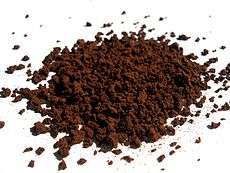
Instant coffee is a drink derived from brewed coffee beans. Through various manufacturing processes the coffee is dehydrated into the form of powder or granules. These can be rehydrated with hot water to provide a drink similar (though not identical) to conventional coffee. At least one brand of instant coffee is also available in concentrated liquid form.
Decaffeinated
A decaffeination process removes caffeine from coffee beans to lower the caffeine content.[68] Four main methods are used to extract the caffeine: water method, where the beans are soaked in water; ethyl acetate method, where the beans are washed in a solution of water and ethyl acetate; carbon dioxide method, where either liquid or "supercritical" (between liquid and gas) carbon dioxide is applied to the beans at high pressure; dichloromethane method, where dichloromethane, a solvent, is used to dissolve the caffeine.[69] Decaffeinated coffee grew in popularity over the last half of the 20th century, mainly due to health concerns regarding over consumption of caffeine.[70][71][72] Decaffeinated coffee, sometimes known as "decaf", may be drunk as regular brewed coffee, instant, espresso, or as a mix of regular caffeine beans and decaffeinated beans.[73][74]
Other
- Affogato
An affogato (Italian for "drowned") is a coffee-based drink or dessert. "Affogato style", which refers to the act of topping a drink or dessert with espresso, may also incorporate caramel sauce or chocolate sauce. When ordered, an Affogato tends to be served with scoops of icecream with a shot (or 2) of espresso poured over the top, sometimes mixed with a liqueur. A white Affogato is the same as a regular Affogato, just with milk added.
- Botz
A common and simple way of drinking coffee in Israel is known as "Botz" (translated as "Mud"). Finely ground Turkish style coffee is put into a cup and boiling water poured onto it. After letting stand for a few minutes to cool and settle, the supernatant coffee is drunk, leaving the grounds behind in the cup.
- Caffè Medici
A Caffè Medici is a doppio poured over chocolate syrup and orange peel, usually topped with whipped cream. The drink originated at Seattle's historic Last Exit on Brooklyn coffeehouse.[75]
- Café Touba
Café Touba is the spiritual drink of Senegal, named after Cheikh Ahmadou Bamba Mbacké (known as Serigne Touba) and the holy city of Touba in Senegal.[76] During the roasting process, the coffee beans are mixed with grains of selim, and sometimes other spices, and ground into powder after roasting.[76] The drink is prepared using a filter, similar to plain coffee. Sugar is often added before drinking.[76]
- Canned coffee
Canned coffee is ubiquitous in Japan, with a large number of companies competing fiercely and offering various types for sale. Canned coffee is already brewed and ready to drink. It is available in supermarkets and convenience stores,[77] with vast numbers of cans being sold in vending machines[78] that offer heated cans in the autumn and winter,[79] and cold cans in the warm months.
- Coffee milk

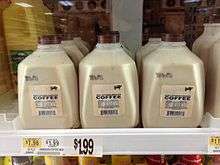

Coffee milk is sold in two ways: prepared coffee milk and coffee syrup. It is a drink prepared made or made by adding a sweetened coffee concentrate called coffee syrup to milk in a manner similar to chocolate milk. It is the official state drink of Rhode Island in the United States of America.[80]
- Indian filter coffee
South Indian Coffee, also known as Mysore Filter Coffee or Kaapi (South Indian phonetic rendering of "coffee') is a sweet milky coffee made from dark roasted coffee beans (70%–80%) and chicory (20%–30%), especially popular in the southern states of Andhra Pradesh, Karnataka, Kerala and Tamil Nadu. The most commonly used coffee beans are Peaberry (preferred), Arabica, Malabar and Robusta grown in the hills of Karnataka (Kodagu, Chikkamagaluru), Kerala (Malabar region) and Tamil Nadu (Nilgiris District,Yercaud and Kodaikanal).
- Pocillo
A shot or small portion of unsweetened coffee, now usually made either using an espresso machine or a moka pot, but traditionally made using a cloth drip, usually served in cups made for the purpose (called "tazitas de pocillo"). It is widely drunk in Latin America, usually as an afternoon or after-dinner coffee. The defining feature is the size, usually half to a quarter the size of the usual ~8 US fluid ounces (240 ml) coffee cups. There are a number of small-sized drinks that use tazitas de pocillo, including sweetened (such as café cubano and café cortado), but these are usually not called a pocillo; rather, the Spanish diminutive suffix "-ito" is usually added to the name of the drink wanted in a pocillo size cup. For example, a pocillo-sized cortado is usually called a cortadito.
See also
- List of coffee dishes
- Coffee substitute
- Coffee preparation – Presentation
- Coffeehouse
- Non-dairy creamer
References
- ↑ Kate Strangfeld (25 January 2013). "Coffee, Lattes, & Macchiatos: Demystified". icingoffthecake.
- ↑ Robert W. Thurston (2013). Coffee: A Comprehensive Guide to the Bean, the Beverage, and the Industry. Rowman & Littlefield. p. 184. ISBN 9781442214422.
- 1 2 Jonathan Morris (2007). "15 Globalisation of Italian Coffee". The Cappuccino Conquests. The Transnational History of Italian Coffee (Exhibition Catalogue). University of Hertfordshire – via academia.edu.
- ↑ "The History of How We Make Coffee". About.com. Retrieved 13 February 2012.
- ↑ James Grierson, "History of the Cafetière", Coffee knowledge, UK: Galla coffee, retrieved 2009-12-23
- ↑ Millman, China (2009-04-23). "Freshen Up; Manual Brewing Techniques Give Coffee Lovers a Better Way to Make a Quality Drink". Pittsburgh Post-Gazette. Retrieved 2009-06-16.
- ↑ "hypecoffee.com". hypecoffee.com. Retrieved 3 August 2015.
- ↑ Hof, Karina (August 13, 2015). "Dutch Coffee: Batavia's Slow-Dripped, Cooled Down Take On A Classic". Sprudge.
- ↑ http://tmagazine.blogs.nytimes.com/2010/07/29/ristretto-kyoto-to-stay/?_r=0#
- 1 2 Peters, A. (2003). Brewing makes the difference. 14th International Scientific Colloquium on Coffee. Association for Science and Information on Coffee. Retrieved 10 August 2013.
- ↑ Jon Bonné (August 20, 2004). "Coffee, without the heat". TODAY. Retrieved Oct 7, 2015.
- ↑ Peter Giuliano. "Why you should stop cold-brewing, and use the Japanese Iced Coffee Method.". Pax Coffea. Retrieved Nov 6, 2015.
- ↑ "Does Cold Brew Coffee Have More Caffeine than Hot Coffee?". Coffee Chemistry. Retrieved Nov 6, 2015.
- ↑ "Does Cold Brew Coffee Have More Caffeine than Hot Coffee?". The Kitchn. July 13, 2015.
- ↑ "4 Things You Need to Know About Cold-Brewed Coffee". May 2, 2015.
- ↑ UNESCO - Intangible Heritage Section. "UNESCO Culture Sector - Intangible Heritage - 2003 Convention :". unesco.org. Retrieved 19 August 2015.
- ↑ "Vacuum Coffee Pots".
- ↑ Johnson, Stacey. Elert, Glenn, ed. "Temperature of Steam in an Espresso Machine". The Physics Factbook. Retrieved 1 April 2013.
- ↑ Joan Korenblit (2014). Knowing Beans About Coffee. Standard International Media. p. 17. ISBN 9781600816482.
- ↑ Stephanie J. Paul Phoenix. How To Make Espresso. Clinton Gilkie. p. 8.
- ↑ Ettore Toscani (2004). L'Italia del caffè. Touring Editore. p. 18. ISBN 9788836530519.
- ↑ Peter Hennessy (2007). Having it So Good: Britain in the Fifties. Penguin. p. 41. ISBN 9780141929316.
- ↑ Alan Davidson (2014). The Oxford Companion to Food. Oxford University Press. p. 521. ISBN 9780199677337.
- ↑ Jonathan Morris (2007). "7". The Cappuccino Conquests. The Transnational History of Italian Coffee (Exhibition Catalogue). University of Hertfordshire – via academia.edu.
- ↑ Jonathan Morris (2007). "11 Speciality Coffee". The Cappuccino Conquests. The Transnational History of Italian Coffee (Exhibition Catalogue). University of Hertfordshire – via academia.edu.
- ↑ Daniel Young (11 Mar 2009). Coffee Love: 50 Ways to Drink Your Java. John Wiley & Sons. p. 16. ISBN 9780470289372.
- ↑ Susan Zimmer (25 Feb 2014). I Love Coffee!: Over 100 Easy and Delicious Coffee Drinks. Andrews McMeel Publishing. pp. 212–217. ISBN 9781449460112.
- ↑ Ramona V. Abella (2003). From Cuba with Love: Recipes and Memories. iUniverse. p. 139.
- ↑ Mario Rizzi (1 May 2014). Real Havana: Explore Cuba Like A Local And Save Money. Full Compass Guides. p. 62.
- ↑ Willis Fletcher Johnson (1920). The History of Cuba. Library of Alexandria. p. 1420.
- ↑ Ted Henken (29 Oct 2013). Cuba. ABC-CLIO. p. 373.
- ↑ Bucuvalas, Tina (1994). South Florida Folklife. University Press of Mississippi. p. 83. ISBN 0878056599.
- ↑ "ESPRESSO VERSUS CUBAN COFFEE". martinezfinecoffees.com. 24 April 2012.
- ↑ Glenn M. Lindgren, Raúl Musibay, Jorge Castillo (2004). Three Guys from Miami Cook Cuban. Gibbs Smith. p. 3.
- ↑ Jodi Mailander Farrell. "Cuban coffee 101". miami.com.
- ↑ A Short History of Espresso, Jim Schulman
- ↑ How to make cafe cremas, May 26, 2005
- ↑ Godsmark, Elizabeth (2014). How to Open & Operate a Financially Successful Coffee, Espresso and Tea Shop. Ocala, FL: Atlantic Publishing Group. p. 150. ISBN 1-60138-905-1.
- ↑ Travis Arndorfer; Kristine Hansen (5 September 2006). The Complete Idiot's Guide to Coffee and Tea. Penguin. p. 121. ISBN 9781440626012. Retrieved 17 April 2014.
- ↑ Tien Nguyen (November 30, 2011). "The Ristretto: The Lame Duck of Coffee". LA Weekly. Retrieved 2015-02-28.
The flavor is more intense, sweeter, less bitter since bitter components are introduced at the end of the shot....Overall, you end up with a much more pleasant and flavorful beverage.
- ↑ Claudia Roden (1994). Coffee: A Connoisseur's Companion. Pavilion Boooks. p. 95.
- ↑ Robert W. Thurston (10 Oct 2013). Coffee: A Comprehensive Guide to the Bean, the Beverage, and the Industry. Rowman & Littlefield Publishers. p. 273. ISBN 9781442214422.
- ↑ Thornton, Milli. "Espresso: The Art of the Perfect Breve". Milliver's Travels. Retrieved 25 November 2015.
- ↑ "Viennese Coffee". vienna.net. Retrieved 3 August 2015.
- ↑ "Time to wake up and smell the flat white". The Independent. Retrieved 3 August 2015.
- ↑ "Starbucks introduces the Flat White to customers in the US and Canada – Starbucks Newsroom". Starbucks Newsroom. Retrieved 3 August 2015.
- ↑ Martin Symington (2010). DK Eyewitness Travel Guide: Portugal. Penguin. p. 407. ISBN 9780756666767.
- ↑ Rodney Bolt (2007). Madeira and Porto Santo. New Holland Publishers. p. 52. ISBN 9781860113642.
- ↑ Sara Lier (2012). Madeira, Porto Santo MARCO POLO Travel Guide. Mair Dumont Marco Polo. pp. PT22. ISBN 9783829780186.
- ↑ "Latte - Definition of latte by Merriam-Webster". merriam-webster.com. Retrieved 3 August 2015.
- ↑ "Latte - definition of latte in English from the Oxford dictionary". oxforddictionaries.com. Retrieved 3 August 2015.
- ↑ How to make Espresso Macchiato - PurelyCoffeeBeans, November 12, 2014
- ↑ "What is a Wiener Melange?". wiseGEEK. Retrieved 3 August 2015.
- ↑ "Vienesse Classics- Julius Meinl". meinlcoffee.com. Retrieved 3 August 2015.
- ↑ CafÉ Sperl. "Cafe Sperl::Wien::Kleines Kaffee ABC". cafesperl.at. Retrieved 3 August 2015.
- ↑ "Vienna Coffee". AllRecipes.
- ↑ Lois Sinaiko Webb (2000). Multicultural Cookbook of Life-cycle Celebrations. ABC-CLIO. p. 170.
- ↑ Rob Humphreys (1 Nov 2008). The Rough Guide to Austria. Dorling Kindersley. p. 185.
- ↑ Corby Kummer (23 May 1994). "Coffee Talk". New York Magazine. 27 (21): 53.
- ↑ Travis Arndorfer (2006). The Complete Idiot's Guide to Coffee and Tea. Penguin. p. 122. ISBN 978-1-59257-544-2.
- ↑ Avani Burdett. Delicatessen Cookbook – Burdett's Delicatessen Recipes. Springwood emedia. p. 15. ISBN 978-1-4761-4462-7.
- ↑ Kevin Sinnott (19 Jan 2011). The Art and Craft of Coffee. Quarry Books. p. 160. ISBN 978-1-61058-094-6.
- ↑ Hugh Merwin (20 January 2014). "Caribou Coffee Forces Duluth Café to Stop Serving 'Depth Charge'". Grub Street.
- ↑ "Dunkin' Donuts Fuels Customers with New Turbo Hot Coffee". Dunkin' Donuts. 15 March 2006. Retrieved 12 October 2013.
- ↑ Allison M Reilly (2 August 2013). "10 Coffee Drinks that You Need to Try". gatewaygrounds.com.
- ↑ "Der 'Pharisäer nach Originalrezept'" [The 'Pharisäer made after the original recipe']. Anwaltseiten 24 (in German). 2 April 2007. Retrieved 11 June 2013.
- 1 2 "Types Of Coffee - Kind Of Coffee Drinks You Can Order In a coffee shop". talkaboutcoffee.com. Retrieved 3 August 2015.
- ↑ "Decaffeinated Coffee Is Not Caffeine-free, Experts Say". sciencedaily.com. 15 Oct 2006.
- ↑ "Decaffeination". International Coffee Association.
- ↑ Charline Caldwell (7 May 1985). "Popularity of decaffeinated coffee is on the increase". Bulletin Journal.
- ↑ "What Is IT About Coffee?". Harvard Medical School. 1 Jan 2012.
- ↑ Gene A. Spiller (1997-10-09). Caffeine. CRC PressDate= 12 Dec 2010. p. 218. ISBN 9781420050134.
- ↑ "Caffeine content for coffee, tea, soda and more". mayoclinic.org.
- ↑ Fran Schumer (27 October 1996). "Half Caf, Half Decaf . . .". New York Times.
- ↑ Connors, Brian. "The Coffeehouse Dictionary: A (Hopefully) Non-Partisan Guide to Coffee Talk".
- 1 2 3 BBC Afrique (15 August 2012). "Café Touba, du bonheur plein la tasse" (Reprint) (in French). seneweb.com. Retrieved 1 January 2013.
- ↑ "Convenience Store Coffee Hits the Top in Japan - NACS Online – News & Media Center – News Archive". nacsonline.com. Retrieved 3 August 2015.
- ↑ "Vending machine marketing deal for Harris Tweed". Herald Scotland. Retrieved 3 August 2015.
- ↑ "TV: Anthony Bourdain 'Parts Unknown' heads to Tokyo". Press Enterprise. Retrieved 3 August 2015.
- ↑ RI.gov. "State of Rhode Island website "Facts and Figures"". Ri.gov. Retrieved 2011-11-28.
External links
-
 Media related to Coffee by type at Wikimedia Commons
Media related to Coffee by type at Wikimedia Commons
